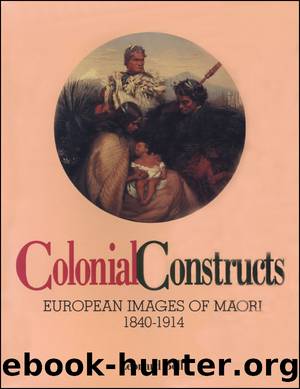Colonial Constructs by Leonard Bell

Author:Leonard Bell [Bell, Leonard]
Language: eng
Format: epub
Tags: History, Art
Publisher: Auckland University Press
Published: 1991-12-31T16:00:00+00:00
88. Thomas Downes, The Sale of Wanganui to the New Zealand Company, oil, 762 × 915 mm, Private Collection.
— a dualistic view that echoes Grey. As the quoted remarks of reviewers and Andersen indicate too, other Europeans recognised the potential the Maori past had for the construction of a necessary past for themselves in New Zealand. For instance, the ethnologist Percy Smith, a member of the A.S.A. in the 1890s, argued:
We … erroneously think that history commenced with the advent of the white man to these shores. It is not so however. Prior to our coming the … race we are now supplanting had a history of its own … Happily we have arrived at a stage in the development of this country, when a few students … are making the early history of the country the subject of earnest study, and are collecting from the old men of the Maori race, the material on which a future history must be founded.29
This passage prefaced the book Old Whanganui (1915) by T. W. Downes, who also painted and drew pictures of Maori, some of them copies of or based on Gilfillan’s work from the 1840s. Several were reproduced in Old Whanganui, most notably a large oil, The Sale of Wanganui to the New Zealand Company (Fig. 88). Here then was a conjunction of the idea that the formulation of New Zealand history for Europeans should incorporate the Maori past with an historical painting featuring Maori. It is not difficult to establish links between the historical paintings and contemporaneous ethnological and historical writing sustained by this need for a past.
The call for Maori historical painting and the attribution of high status to such work coincided with a major expansion of interest among Europeans in the origins and culture of Maori, with major developments in the practice of ethnology. For instance, the Polynesian Society (of which Smith was a founder and President) and the Journal of that Society, the prime forces in ethnological investigations at this time, were founded in 1892, and several pioneering studies of Maori history and culture published.30 Those collectors of New Zealand historical material and builders of libraries and archives of New Zealand history, past and present, Dr Hocken and Alexander Turnbull, included visual representations of Maori in their collections.31 One of the major institutions concerned with excavating, salvaging the Maori past, the Colonial Museum, under the directorship of Augustus Hamilton, himself a painter and photographer of Maori subjects, also collected paintings of Maori. Writers, artists, ethnologists, and collectors were all contributing to the piecing together of a history; to co-opt Norman Bryson’s observation: ‘… in history event and scripture [or representation] fuse, for the historical is not only that which has occurred but that which has occurred in writing [or representation]’.32
The ethnological investigations and the collecting of Maori historical and cultural material were far from ideologically neutral or disinterested. As elements in that drive for a national and indigenous European culture they amounted to an absorption (and transformation) of aspects of a subordinated culture into the dominant.
Download
This site does not store any files on its server. We only index and link to content provided by other sites. Please contact the content providers to delete copyright contents if any and email us, we'll remove relevant links or contents immediately.
| Africa | Americas |
| Arctic & Antarctica | Asia |
| Australia & Oceania | Europe |
| Middle East | Russia |
| United States | World |
| Ancient Civilizations | Military |
| Historical Study & Educational Resources |
The Third Pole by Mark Synnott(690)
Money for Nothing by Thomas Levenson(638)
The Economist (20210109) by calibre(591)
Christian Ethics by Wilkens Steve;(585)
Made in China by Anna Qu(557)
100 Posters That Changed The World by Salter Colin T.;(511)
Reopening Muslim Minds by Mustafa Akyol(501)
The Irish Buddhist by Alicia Turner(494)
Routledge Handbook of Contemporary India by Knut A. Jacobsen(489)
Nonstate Warfare by Stephen Biddle(479)
The Age of Louis XIV: The Story of Civilization by Will Durant(472)
Culture by Terry Eagleton(470)
The Great Pyramid Void Enigma by Scott Creighton(465)
Ideology by Eagleton Terry;(456)
The Shortest History of China by Linda Jaivin(449)
Objects of Vision by Saab A. Joan;(438)
Banaras: CITY OF LIGHT by Diana L. Eck(436)
The Jews of Silence: A Personal Report on Soviet Jewry by Elie Wiesel(434)
Sybille Bedford by Selina Hastings(426)
